How to propagate chlorophytum?
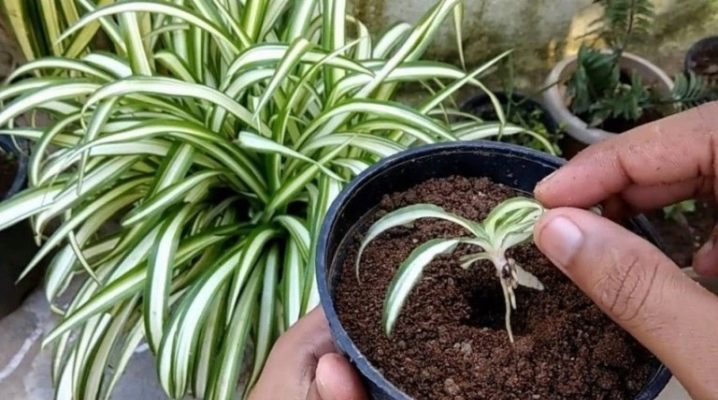
Many housewives love to decorate their home with unusual indoor plants, which give the interior more comfort and coziness. The variety of colors is simply amazing. Chlorophytum does not require any special care, however, it has several significant nuances that are important for its reproduction.
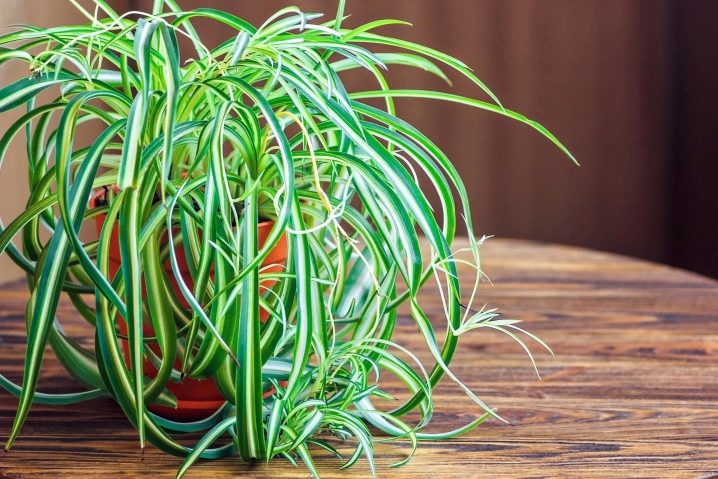
Breeding rules
Chlorophytum is a herbaceous member of the Asparagus family. It belongs to long-term flowers, the roots of which are presented in the form of tubers with small shoots, which allows, with the right approach at home, to deal with its seedlings. For its appearance among the population, chlorophytum is called a "spider". Its origin is unknown, however, references in documents date back to the 18th century. At the moment, this plant is grown all over the world, so the exact number of its species is unknown (about 250).
Chlorophytum grows in the form of long, oblong leaves, the length of which can reach 50 centimeters, growing directly from the root of the plant. The way and time of flowering differs depending on the variety of the given plant. Some form small inflorescences of a light color, from which fruits then appear. On others, buds appear, from which young leaves are subsequently formed. For propagation by seeds, only dried boxes with them are chosen.
For the purpose of reproduction with the help of children, young strong seedlings are chosen, since large ones may no longer take root.
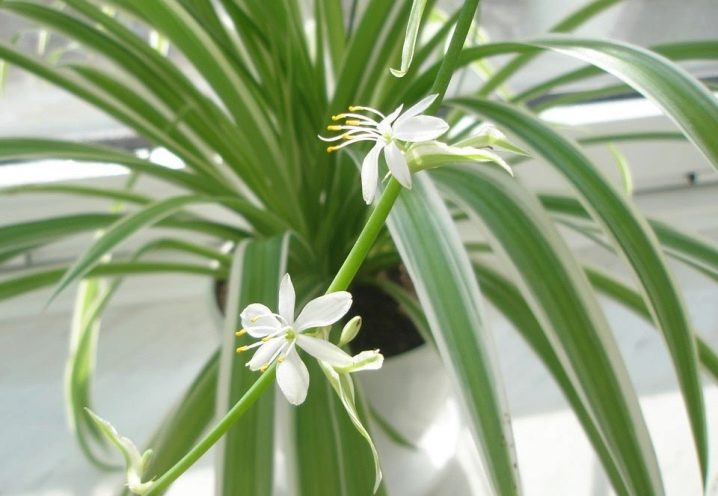
For those who want chlorophytum to actively grow and give birth, it is necessary to take good care of it. This plant is completely undemanding to care for, which is why it has taken root in almost all corners of the planet. The only thing that chlorophytum needs is regular soil moisture. This indoor pet grows quickly with proper care and, with active life, quickly begins to bloom. Also, this flower is a natural air purifier.
Before you start reproducing a flower, you should make sure that the plant is healthy and strong, since the children and processes of the diseased chlorophytum will not take root. For propagation, you need to choose only strong and sturdy cuttings and seed boxes. You need to prepare in advance everything you need for seating - containers with ready-made soil (sand and fertilizer) or a container with water, gardening tools, gloves, as well as a prepared place where the seedling will be most comfortable (with a moderate level of humidity and temperature).
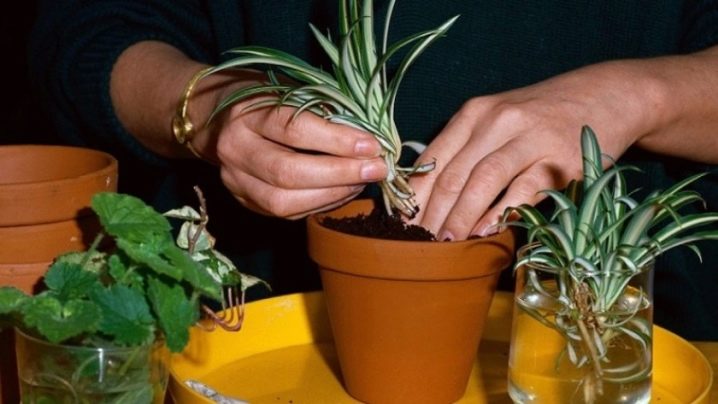
The ways
Most of the people whose homes are decorated with this wonderful flower are wondering how to propagate this plant at home. You should know that, if necessary, in addition to reproduction, chlorophytum should be periodically transplanted for its further normal development and life. This should be done as soon as the root system has grown so that it began to occupy the entire volume of the pot. This process will not take long. For it, it is necessary to purchase a larger container in which the entire transplanted flower with all its contents is placed. It is enough just to fill the missing areas with new soil.
It is best to do the transplant (as well as reproduction) in the fall. The container should be free for the plant and wide, not deep.
It is better to choose a material of ceramic or plastic, which retains moisture for the longest time. There are several ways of reproduction of chlorophytum, which is carried out during the vegetative period of the flower's life. Among them, reproduction by children, cuttings and seeds.
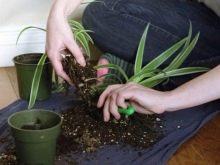

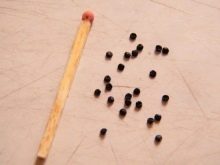
Children
Chlorophytum begins to bloom at a fairly early period, already in the second year of life. This can be seen in the appearance of his children on the mustache. In order for the children to start growing and developing on their own, they need to be placed in the ground of the pot of an adult plant, in no case cutting it off before rooting. Another way of reproduction of chlorophytum with the help of children is to place them in a container with water until the roots appear. After that, the seedling can be planted in a separate pot with soil.
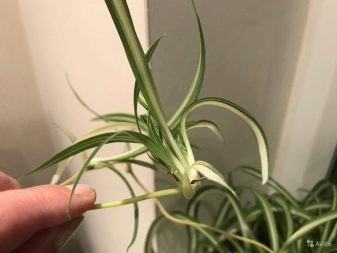
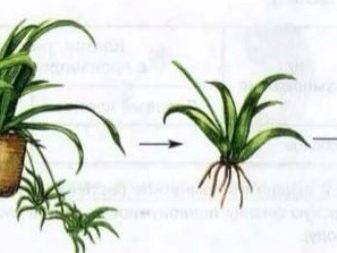
Cuttings
This breeding method is the easiest, gardeners choose it most often. To grow new chlorophytum in this way, it is enough to place a good cutting in a glass of water. And as soon as the cutting starts to root, it should be planted in the usual way in a free container with earth.
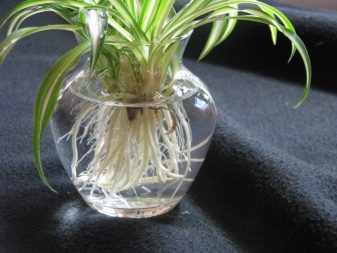

Seeds
In order for the planted seeds of chlorophytum to give their results, it should be done in the autumn season. Dry seed boxes are collected from the plant. They are soaked in advance for a day in water or a diluted growth regulator. Then the seeds are tamped into a pot consisting of a mixture of sand and fertilizer. From above, the container is covered with a glass lid, plastic bag or cling film. You need to keep the planted seeds in a semi-dark place. From time to time, the sprouts should be opened for oxygenation and spraying.
The first seedlings appear in 3-5 months. After their appearance, the lid must be opened much more often in order for the flower to begin to adapt to external conditions. With the appearance of the first small leaves, chlorophytum can be transplanted into a pot for an adult plant. Besides seeds, chlorophytum can be propagated by rosettes. To do this, a poured socket is poured into a container with soil. In this case, the flower quickly adapts to new conditions and begins to grow.

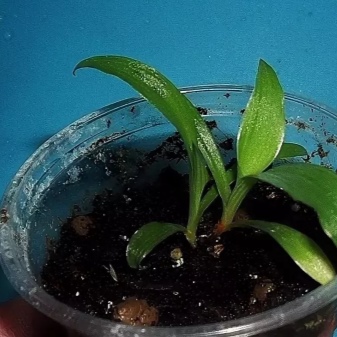
Post-seedling care
After transplanting, indoor plants require additional care. The temperature regime in the room should not be too low (at least 10 degrees), but at the same time should not exceed 20 degrees. The flower loves natural light, so you don't need to place the plant in dark corners of the room.
As for watering, chlorophytum does not like moisture too much. Watering should be done in moderation, focusing on the dryness of the soil. In the summer season - about every other day, in winter - based on the temperature and humidity in the room. Provided that the temperature remains the same as in summer, exactly the same. However, if the temperature has dropped, then the number of waterings is reduced to 2 per week. In addition, you must not forget to monitor the condition of the soil.
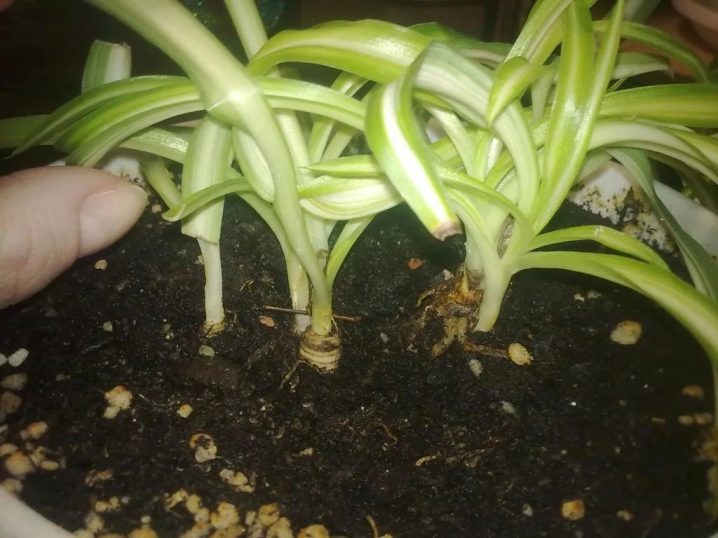
You do not need to touch the leaves of chlorophytum, as they are quite sensitive. In order to get rid of the dust accumulated on the leaves, it will be enough to spray the plant at least once a month. Often this is not necessary either. Many people have a question about cutting off the whiskers, which appear in adult representatives of chlorophytum. This should be done if you want the flower to have more leaves. In this case, they can be carefully trimmed.
If in the future you want to use the seeds for planting chlorophytum, you do not need to touch them. The only condition is that you need to watch out for dry leaves, which must be removed periodically. Fertilization is necessary for the plant during the growing season (spring-autumn). If you feed the flower once a month with various stimulants and minerals, very soon you will be able to plant the plant in one of the above ways.
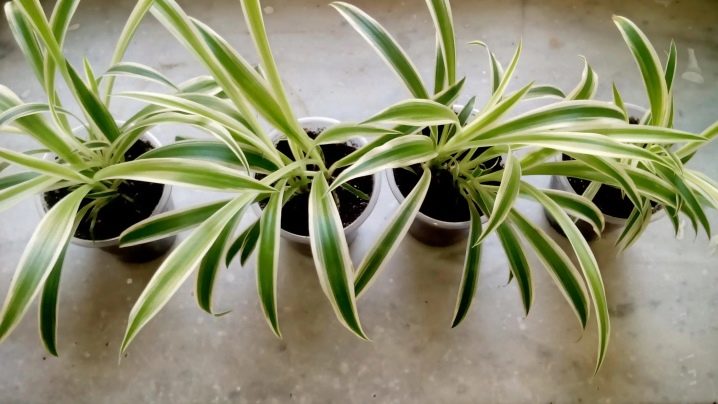
Possible problems
Due to improper care, some problems may arise after the transplant.
- Chlorophytum leaf tips are dry and brittle.The reason for this may be a lack of water or an excess of sunlight, as well as low humidity in the room.
- The leaves of the plant began to blacken and rot. This is due to excess moisture in the soil, which is caused by frequent watering of the indoor plant.
- Chlorophytum leaves began to turn yellow. The reason was the lack of light. This plant loves well-lit rooms. With a lack of minerals, the plant can also begin to wilt. This can happen when the flower is cramped in the pot. To make sure of this, you should lift the leaves and examine the root system of the plant. It may be time to transplant the chlorophytum into a wider container.
- Delayed growth of chlorophytum. This can be caused by an incorrectly sized pot, as a large container is also not suitable. The flower will not grow until the roots fill the entire space. Growth can stop if the soil for chlorophytum is too heavy or insufficiently saturated with minerals and fertilizers.
- If the plant does not have children for a long time, it means that it is cramped in this pot or there is not enough sunlight.
- The plant does not let the whiskers that are characteristic of it. This is due to a lack of light, as well as fertilization and watering. We need to reconsider caring for him.
- Chlorophytum lost its previous color, became more faded and dull. Low lighting is the reason. Therefore, the plant must be placed on a windowsill or at least to a constant light source.
- The fragility of flower leaves appears when there is a lack of lighting or when there is an excess of fertilizers in its soil.
- If the flower begins to rot, this is due to the inappropriate air temperature (too low), which causes moisture retention in the ground.
- If the leaves of an adult flower begin to curl, it means that it needs to be fed with fertilizers and later transplanted into a freer container.
- The appearance of spots on the leaves, as well as root rot, are caused by pathogenic bacteria. Immediately, you need to purchase a plant protection agent against fungus.
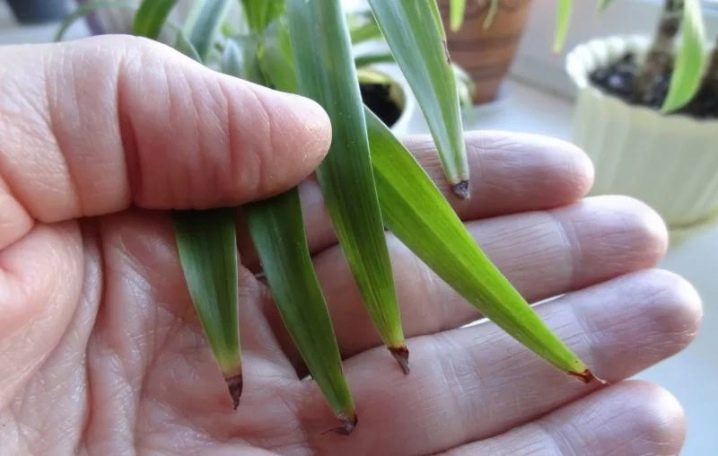
How to propagate chlorophytum with rosettes, see below.





























The comment was sent successfully.